As a regular reader, you may recall I held a mezcal tasting at our apartment in NYC this past spring (and did I mention it rocked, of course?!). As we are now spending several weeks in Vail this summer, I thought it was wise to continue planting mezcal seeds wherever I travel. Once planted, mezcal seeds tend to flourish because mezcal is a discovery process, and usually, once discovered, the converted keep coming back!
So with this in mind, we held a tasting for friends and family this past weekend showcasing some of the finest mezcals that can be found in the U.S. As with my previous tasting, I had scorecards, groupings, and tasting notes from the brands (unless they could not be found).
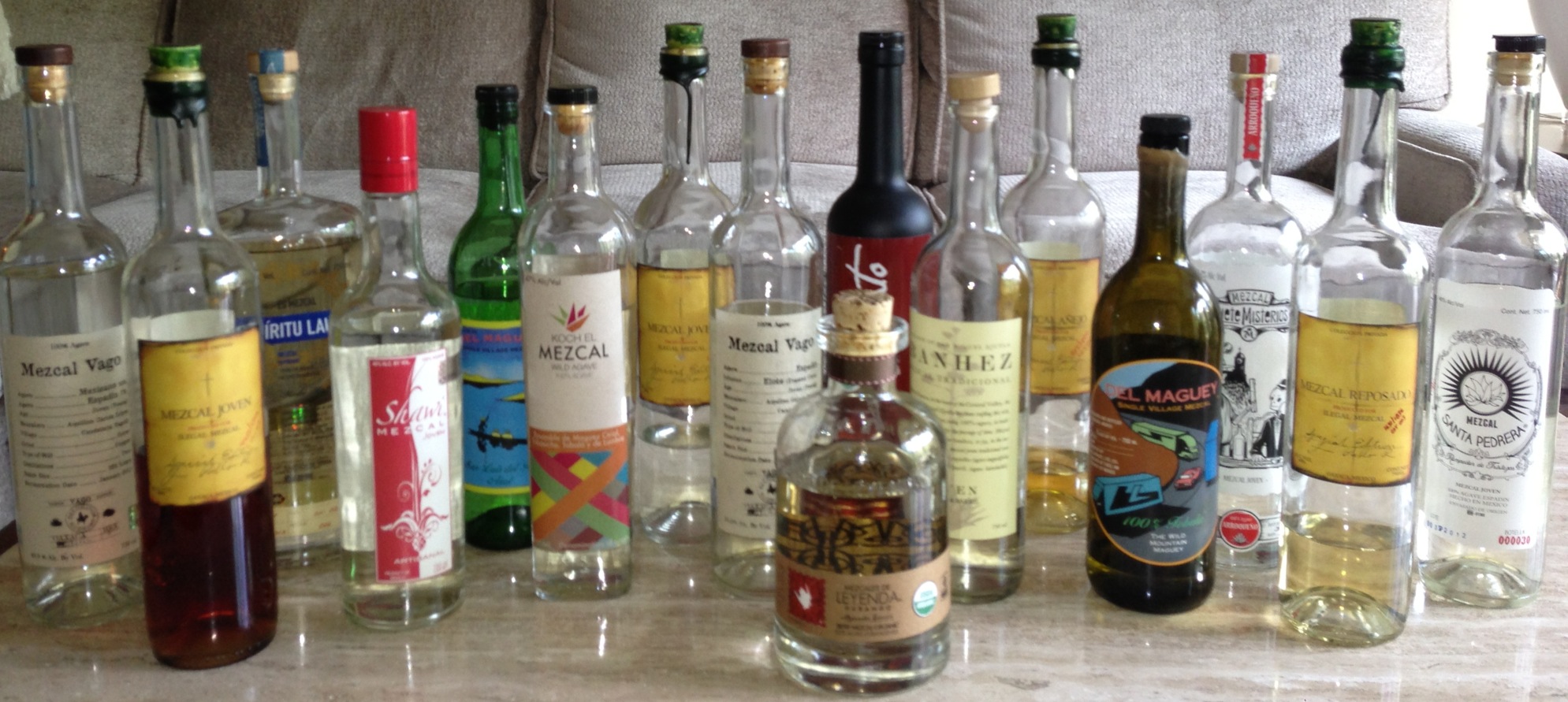
I varied the groupings from the previous tasting largely based on the bottles that I had – in this case 16 bottles! While that is about half the number from my previous tasting, it still appears to be too many. Why? Why? Why so many? Well first, why not? Second, there are so many great mezcals on the market and I cannot deny my friends. How selfish would I be if I held back inventory? And third, and really most importantly, the variety of fabulous mezcals is so broad that I want to display a reasonably full range of the diversity that mezcal has to offer. So 16 bottles appears to be a lot for a tasting, but in reality, even with that many bottles, we are still just scratching the surface.
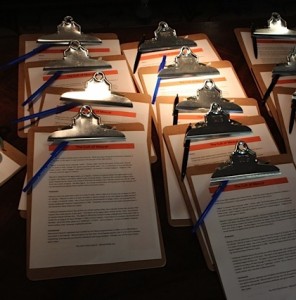
So here is what I did. I divided the bottles into 3 groupings: the Wild Agave Group, the Aged Group, and the Espadin Group. As you will see, these groupings are not perfect, and there was a bit of bending of the grouping rules to fit certain bottles into the mix. So don’t send me aggressive comments asking how I could compare a reposado to an anejo, and why a blue agave mezcal is in with the espadin group. It was for convenience and there was some method to my madness.
I recognize some of the pitfalls. But also, remember this is all about fun! Let’s not take it too seriously – it’s mezcal! So let’s get to the groupings, the results, and the comments. I will use 3 ranking categories here to parse the results. Consistently favored means the bottle was usually in the top one or two of the group. Middle of the pack means results were varied but generally favorable. And universally panned speaks for itself.
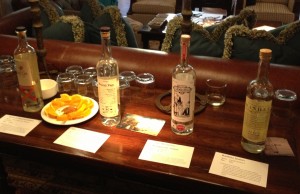 The first group was the Wild Agave Group, also known as the “silvestres”, which is the Spanish word for “wild”. Here are the bottles which were featured, the type of agave, and the results and comments:
The first group was the Wild Agave Group, also known as the “silvestres”, which is the Spanish word for “wild”. Here are the bottles which were featured, the type of agave, and the results and comments:
Wild Agave Group
- Siete Misterios, Agave Arroqueno. Consistently favored. Highly praised and heavily revisited as the night wore on. “Anise. Smoky and smooth.”
- Mezcal Vago, Agave Mexicano. Middle of the pack. “Floral, vanilla, smooth, fiery.”
- Koch el Mezcal, Agaves Cirial, Tobasiche, Tobala, & de Lumbre. Consistently favored. “Extremely smooth, smoky, spicy, floral, peppery finish.”
- Banhez, Agave Barrill. Middle of the pack. Strangely polarizing as some thought this was the best of the group (“bananas -wow!, sweet, smoothest”) and some thought it was the worst (“aircraft fuel, boring”). Personally, I think it is excellent.
- Del Maguey, Agave Tobala. Consistently favored. “Mango, sweet, pablano, quite smooth, fruity.”
- Mezcales de Leyenda, Durango, Agave Durangensis. Middle of the pack. “Ash, smooth, easy to drink, less complex.”
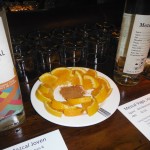
Traditional Mezcal Companion: Oranges and Salt Con Gusano
The clear winners in this group were the Siete Misterios, Koch, and Del Maguey. For me, the Siete is amazing – most agreed. Many were greatly impressed with the complexity and diversity of flavors across this group.

The Aged Group
- Ilegal Reposado. Consistently favored. “Lovely, smooth, delicious, chocolate, best nose, wood, smoke.”
- Espiritu Lauro Reposado. Middle of the pack. “Smooth, interesting, smoky.”
- Ilegal Anejo. Consistently favored. “Subtle, smooth, woody aroma.”
- Sacacuento Anejo. Consistently favored. “Fabuloso, smoky, vanilla, butterscotch finish.”
- Mezcal PhD, Special Bottling. This is home aged Ilegal Joven. It was aged for 8 weeks in a 3 liter barrel to get to anejo quality (and at this stage it is already excellent). Then I decanted the mezcal and put Bordeaux wine into the barrel for a month. Then I poured out the wine, and reloaded the mezcal for a two week finishing. At the tasting, this special home aged mezcal was consistently favored. “Very special, smooth, can smell the wine but not taste it. Best of the best.”
Really, there is not a bad one in the bunch here. They were all highly praised. As the night progressed (and after the pizzas were ordered and devoured), people tended to congregate around this table and the sampling of all of these continued.
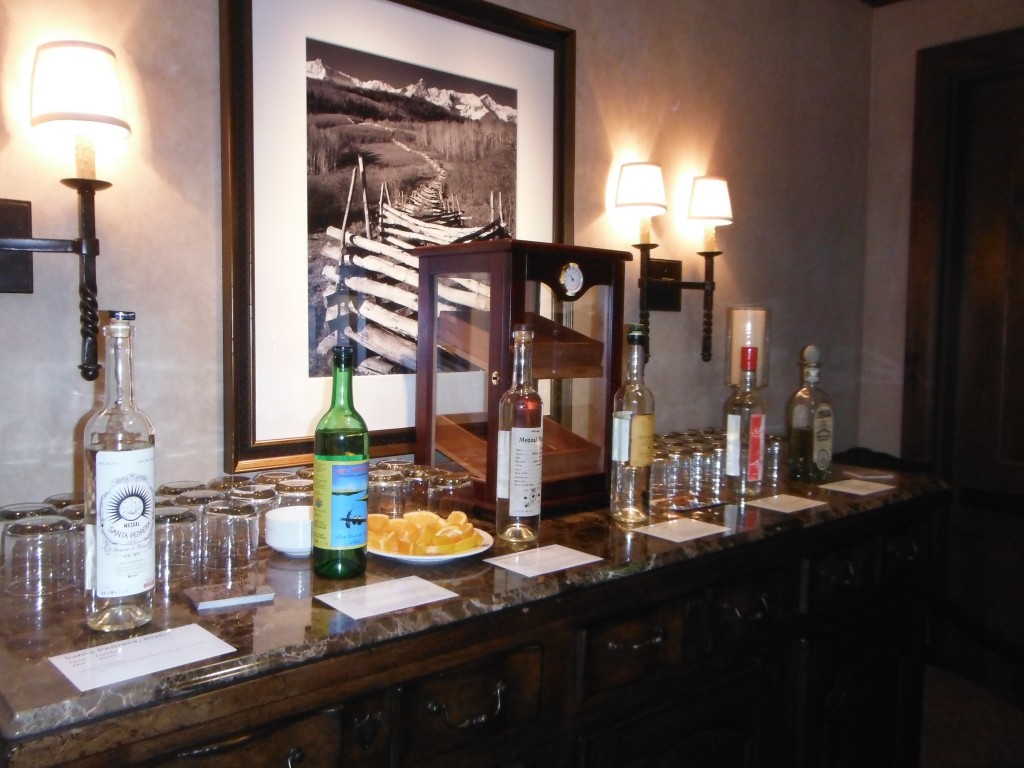
The Espadin Group, Joven
- Ilegal Joven. Consistently favored. “Smoothest of the bunch”
- Mezcal Vago Elote. Consistently favored. “Excellent, sweet – perhaps the corn?”
- Shawi Joven. Consistently favored. “Spicy, vanilla, anise, ash, pepper, fruit”
- Santa Pedrera. Universally panned. “Harsh, motor oil, eh!”
- Del Maguey San Luis Del Rio – Azul. Middle of the pack. “Floral, too strong, acidic, mouthwash, light, sweet”
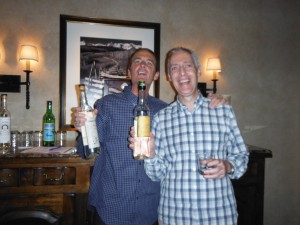
All shined in this group except for the Santa Pedrera. Ilegal always rocks as the flavor profile is deliberately approachable for a mezcal. It is not meant to reach out and grab you by the throat, but rather to seduce with a gentle smokiness. The Vago Elote (“elote” means “corn”) is fantastic and comes from a family recipe where roasted corn is put into the still in the 3rd distillation. It seems to add a bit of sweetness on the back end though I have a hard time getting that every time – it doesn’t matter – it is good!
The Shawi is also unique. First, it is relatively inexpensive. Second, it has a flavor profile unlike any mezcal I have ever tasted. I cannot quite put my finger on it but several participants felt strongly about an anise and ash flavor. I am not sure what it is and I still cannot tell if I love it or hate it!
The Santa Pedrera, on the other hand, was the least favored of the bunch. Some thought it really sucked (hence the motor oil comment). I am OK with it but there are certainly far better jovens.
So that wraps up the tasting. Several of the participants were new to mezcal, and they walked away (maybe crawled) with an excitement and appreciation of the diversity and quality of this premium spirit. A few called it a life changing event (OK, I made that part up).
If you want to have your own mezcal tasting drop me a line and we can compare notes, or I am happy to provide guidance. Remember, drink it how you like it and don’t take it too seriously! In the meantime, drink mezcal!






Will attempt to pick up a bottle of Misterios based on my tasting and am willing to take a flyer on the Shawi….will report back on my experience with the Shawi.
I think it’s worth noting that two mezcals in the espadin category are lower proof than the others. Shawi at 36% and Ilegal at 40%. Perhaps they serve as great introductory mezcals, but for the more seasoned Mezcal drinker, the others might provide a more complex profile. Might be worth noting the alc. content, and giving a bit of background on the judges. Any which way, looks like fun!
Thanks for your thoughts. I think you are on point on one thing and astray on another. I agree that the ABV is a relevant metric as lower ABV mezcals, in general, probably are smoother than higher ABV’s. But I say “in general” because it is not necessarily so. The Siete Misterios at 48.7% was enjoyed by all (by both mezcal novice and enthusiast) and some of the other high alcohol mezcals at the tasting were favored over lower ABV’s. But directionally, I agree with you and think it is a relevant point, and one that as “referee” of the tasting and eventual scribe for the tasting, it is something that I can and should note in the blog post. The good thing is that there is an EDIT button for me so I can revise!!
Where I think you are a bit astray is on the spirit of the event and the goals. This was not a spirits competition but rather a group of friends getting together to have fun and learn more about mescal – most in the group know little more than that I am very passionate about it so they are curious and want to have a fun night and learn something. They are not “judges” – this was about FUN!
That said, I think it is very instructive for brands, producers, marketers, bartenders, and other industry professionals that are interested in mezcal, to know what people like to drink. At the end of the day, what tastes good is the question we were answering at this tasting. In this case, they pretty much all did because I hand picked high quality mezcals (and only one bottle was not well received). The category is young and I think it likely that most people who dip their toe into the mezcal waters will favor a smoother mezcal – however defined. I think it is best defined by what you like to drink – what tastes good to you. It may be a lower ABV mezcal, it may be a silvestre, it may be aged, it may be high ABV. For example, while there was little direct comparison going on, the aged stuff was probably favored by most over the jovens. So in the end the tasting was about 1) FUN, and 2) seeing what people favored, no matter what the reason.
I hope this all makes sense. Thanks for reading and commenting!
P.S. The label on my Shawi says 40% ABV, not 36%.
I agree with most everything you say here. I used the word “judge” because of the format presented so I don’t think Im too off base there. Of course reading this we can see it is just for fun and crew of interested people looking to learn more. What I would like to see is simply a bit more information in the form of Alc. Cont. presented so that the reader may draw some natural conclusions that aren’t misguided. If you taste a navy strength gin next to a strawberry daiquiri, which one is smoother? Way over the top I know, but none the less it’s still apples and oranges on some level. To me reading through the article, it just seemed a bit of a foregone conclusion. You seem very knowledgable and I imagine have tried more mezcals that 99.9% of the rest of us, so I really just wanted to see your analysis of the way things went. For instance, with that beautiful Siete Misterios Arroqueño, what was it that turned those guys on about it. Was it the earthy tones coming through due to it’s distillation in clay? A bit of analysis of the results from the phd would be fun to read! (and write?)